
XXXI Simpósio Brasileiro de Telecomunicações
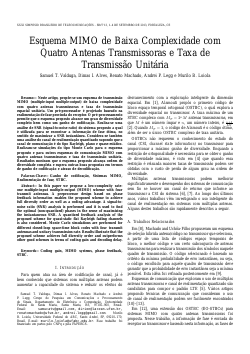
Esquema MIMO de Baixa Complexidade com Quatro Antenas Transmissoras e Taxa de Transmissão Unitária
Samuel T. Valduga, Dimas I. Alves, Renato Machado, Andrei P.Legg, Murilo B. Loiola
DOI: 10.14209/sbrt.2013.42
Keywords: Ganho de codificação Sistemas MIMO Realimentação de fase STBC
Abstract
In this paper we propose a low-complexity rate-one multiple-input multiple-output (MIMO) scheme with fourtransmit antennas. A preprocessor design based on phasefeedback information enables the proposed scheme to achievefull diversity order as well as a coding advantage. A signal-to-noise ratio (SNR) analysis is performed and it is used to findthe optimal (non-quantized) phases in the sense of maximizingthe instantaneous SNR. A quantized feedback analysis of theproposed scheme for quasi-static flat Rayleigh fading channelsis also considered. Monte Carlo simulations are performed fordifferent closed-loop space-time block codes with four transmitantennas and unitary transmission rate. Results illustrate that theproposed scheme achieves full diversity order and outperformsother good schemes in terms of coding gain and decoding delay.Download
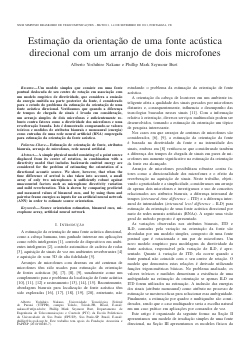
Estimação da orientação de uma fonte acústica direcional com um arranjo de dois microfones
Alberto Yoshihiro Nakano, Phillip Mark Seymour Burt
DOI: 10.14209/sbrt.2013.39
Keywords: Source orientation estimation binaural cues mi-crophone array artificial neural network
Abstract
A simple physical model consisting of a point sourcedisplaced from its center of rotation, in combination with adirectivity model that includes backwards emitted energy areconsidered for the problem of estimating the orientation of adirectional acoustic source. We show, however, that when thetime difference of arrival is also taken into account, a smallarray of only two microphones is sufficiently robust againstunaccounted factors such as microphone directivity variationand mild reverberation. This is shown by comparing predictedand measured values of binaural cues, and by using them andpairwise frame energies as inputs for an artificial neural network(ANN) in order to estimate source orientation.Download
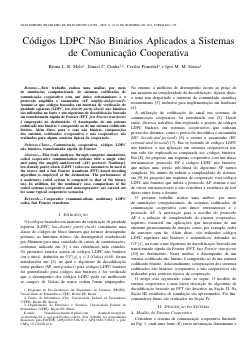
Códigos LDPC Não Binários Aplicados a Sistemas de Comunicacão Cooperativa
Bruna L. R. Melo, Daniel C. Cunha, Cecilio Pimentel, Igor M. M. Souza
DOI: 10.14209/sbrt.2013.40
Keywords: Cooperative communications nonbinary LDPCcodes fast Fourier transform
Abstract
This work analyzes, through computer simulations,coded cooperative communication systems with a single relayand using the amplify-and-forward (AF) protocol. Nonbinarylow-density parity-check (LDPC) codes are assumed to be used atthe source and a fast Fourier transform (FFT)-based decodingalgorithm is employed at the destination. The performance ofa nonbinary coded system is compared to that of the binaryone. In addition, for the nonbinary case, comparisons of thecoded systems (cooperative and noncooperative) are carried outfor some typical cooperative scenarios.Download
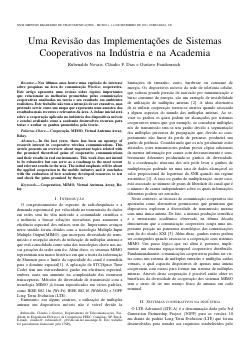
Uma Revisão das Implementações de Sistemas Cooperativos na Indústria e na Academia
Rubenaldo Novais, Cláudio F. Dias, Gustavo Fraidenraich
DOI: 10.14209/sbrt.2013.43
Keywords: Cooperation MIMO Virtual Antenna Array Re-lay
Abstract
n the last years, there has been an upsurge ofresearch interest in cooperative wireless communications. Thisarticle presents an overview about important topics related withthe promised theoretical gains of cooperative communicationsand their results in real environments. This work does not intendto be exhaustive but can serve as a roadmap to the most recentand relevant results in the area. The initial emphasis will be aboutthe applied cooperation in the mobile industry and it concludeswith the evaluation of how academy developed resources to testand check the gains promised by theory.Download

Códigos Reed-Solomon Aplicados a Sistemas de Marca D’Água Digital no Domínio da Frequência
Maxwell V. da Silva, Daniel C. Cunha, Juliano B. Lima
DOI: 10.14209/sbrt.2013.44
Keywords:
Abstract
This paper evaluates, through computer simulations, a coded watermarking system in the discrete wavelet transform (DWT) domain. The robustness of the systemis analyzed in terms of the length of Reed-Solomon (RS)codes and the decoding algorithms adopted. Two scenarios are investigated: transmission of the watermarked image by an additive white Gaussian noise (AWGN) channel and joint photographic expert group (JPEG) compression of the watermarked image. The results shows that, depending on the scenario investigated, the length of the code and the decoding algorithm carry on differently to increase the robustness of the watermark.Download
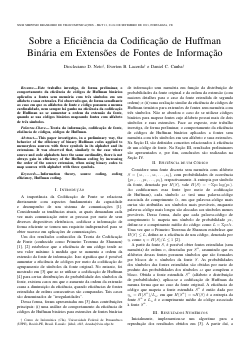
Sobre a Eficiência da Codificação de Huffman Binária em Extensões de Fontes de Informação
Diocleciano D. Neto, Everton B. Lacerda, Daniel C. Cunha
DOI: 10.14209/sbrt.2013.37
Keywords: Information theory source coding coding efficiency Huffman coding
Abstract
This paper investigates, in a preliminary way, the behavior of the efficiency of binary Huffman codes applied to memoryless sources with three symbols in its alphabet and its extensions. It was observed that, similarly to the case where source and code alphabets have the same cardinality, there is not always gain in efficiency of the Huffman coding by increasing the order of the source extension, when using binary codes to map sources with alphabet with three symbols.Download
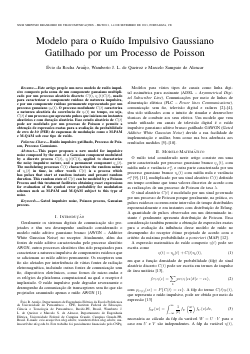
Modelo para o Ruído Impulsivo Gaussiano Gatilhado por um Processo de Poisson
Évio da Rocha Araújo, Wamberto J. L. de Queiroz, Marcelo Sampaio de Alencar
DOI: 10.14209/sbrt.2013.38
Keywords:
Abstract
This paper proposes a new model for impulsive noise composed by the sum of a Gaussian component modulated by a discrete process C(t), ηi(t)C(t), applied to characterize the noisy impulsive nature, and a permanent component ηg(t). The modulating processes C(t) characterizes the random nature of ηi(t) in time, in other words C(t) is a process which has pulses that start at random instants and present random duration. This random state of C(t) can be modeled by a Poisson Process and this treatment facilitates obtaining exact expressions for evaluation of the symbol error probability for modulation schemes such as M-PAM and M-QAM subject to this type of noise.Download
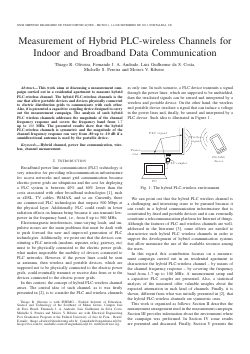
Measurement of Hybrid PLC-wireless Channels forIndoor and Broadband Data Communication
Thiago R. Oliveira, Fernando J. A. Andrade, Luis Guilherme da S. Costa, Michelle S. Pereira, Moises V. Ribeiro
DOI: 10.14209/sbrt.2013.51
Keywords: Hybrid channel power line communication wire-less channel measurement
Abstract
This work aims at discussing a measurement campaign carried out in a residential apartment to measure hybrid PLC-wireless channel. The hybrid PLC-wireless channels is the one that allow portable devices and devices physically connected to electric distribution grids to communicate with each other. Also, it is presented a capacitive coupling device designed to carryout the measurement campaign. The analysis of such hybrid PLC wireless channels addresses the magnitude of the channel frequency response and covers the frequency band from 1.7 up to100MHz. The presented results show that the hybrid PLC-wireless channels is symmetric and the magnitude of the channel frequency response can vary from -80 up to -10 dB if a omnidirectional antenna is used by the portable device.Download
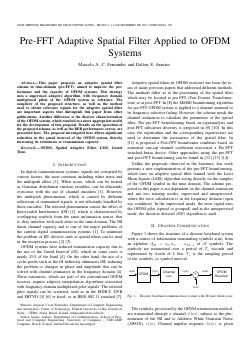
Pre-FFT Adaptive Spatial Filter Applied to OFDM Systems
Marcelo A. C. Fernandes, Dalton S. Arantes
DOI: 10.14209/sbrt.2013.54
Keywords: OFDM Spatial Adaptive Filter LMS GuardTime
Abstract
This paper proposes an adaptive spatial filter scheme in time-domain (pre-FFT), aimed to improve the performance and the capacity of OFDM systems. This strategy uses a supervised adaptive algorithm, with frequency domain multiplexed pilots of the OFDM system as reference. The simplicity of the proposed structure, as well as the method used to obtain reference signals for the adaptive spatial filter are important aspects that distinguish this paper from other publications. Another difference is the discrete characterization of the OFDM system, which resulted in a more appropriate model for the development of this proposal. Details on the operation of the proposed scheme, as well as the BER performance curves, are presented here. The proposal investigated here allows significant reduction in the guard interval of the OFDM system, thereby increasing its robustness or transmission capacity.Download
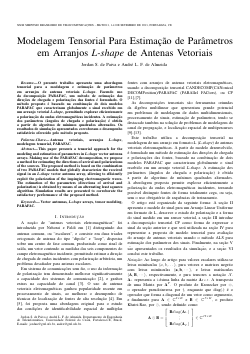
Modelagem Tensorial Para Estimação de Parâmetros em Arranjos L-shape de Antenas Vetoriais
Jordan S. de Paiva, André L. F. de Almeida
DOI: 10.14209/sbrt.2013.56
Keywords: Vector antennas L-shape arrays tensor modeling PARAFAC
Abstract
This paper presents a tensorial approach for the modeling and estimation of parameters in L-shape vector antenna arrays. Making use of the PARAFAC decomposition, we propose a method for estimating the directions of arrival and polarizations of the sources. The proposed method is based on the combinationof two PARAFAC models that globally characterize the received signal in an L-shape vector antenna array, allowing to efficiently exploit the polarization of the impinging electromagnetic waves. The estimation of the parameters (directions of arrival and polarization) is obtained by means of an alternating least squares algorithm. Simulation results are presented to corroborate the satisfactory performance of the proposed method.Download